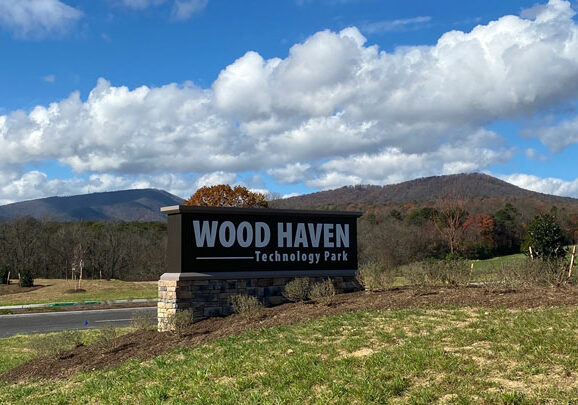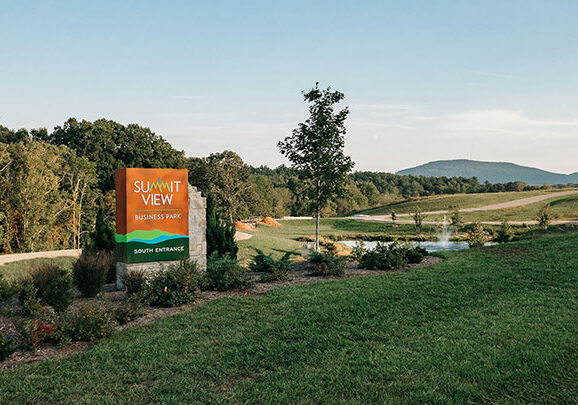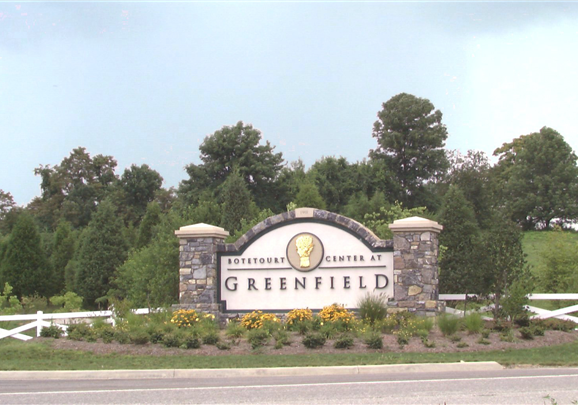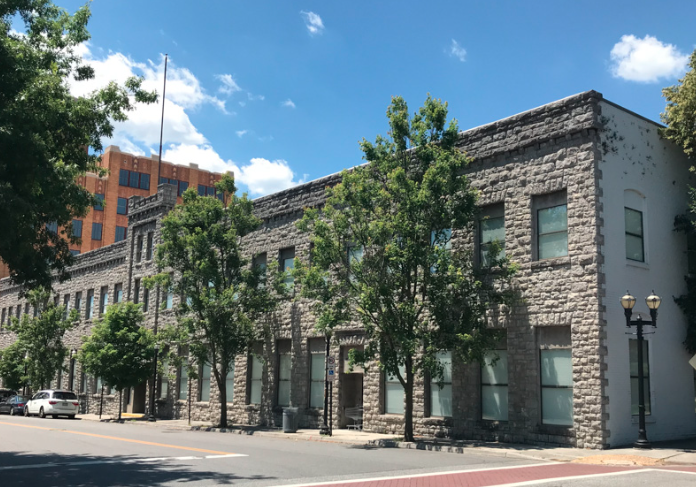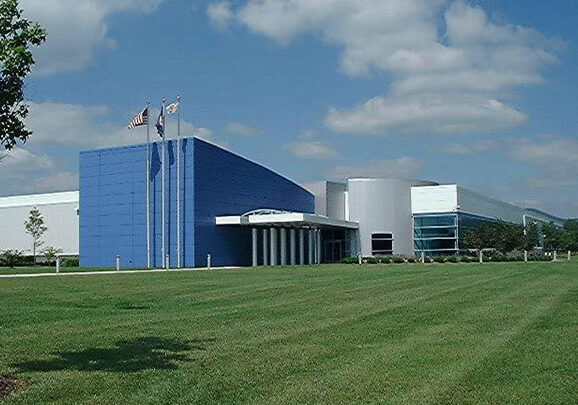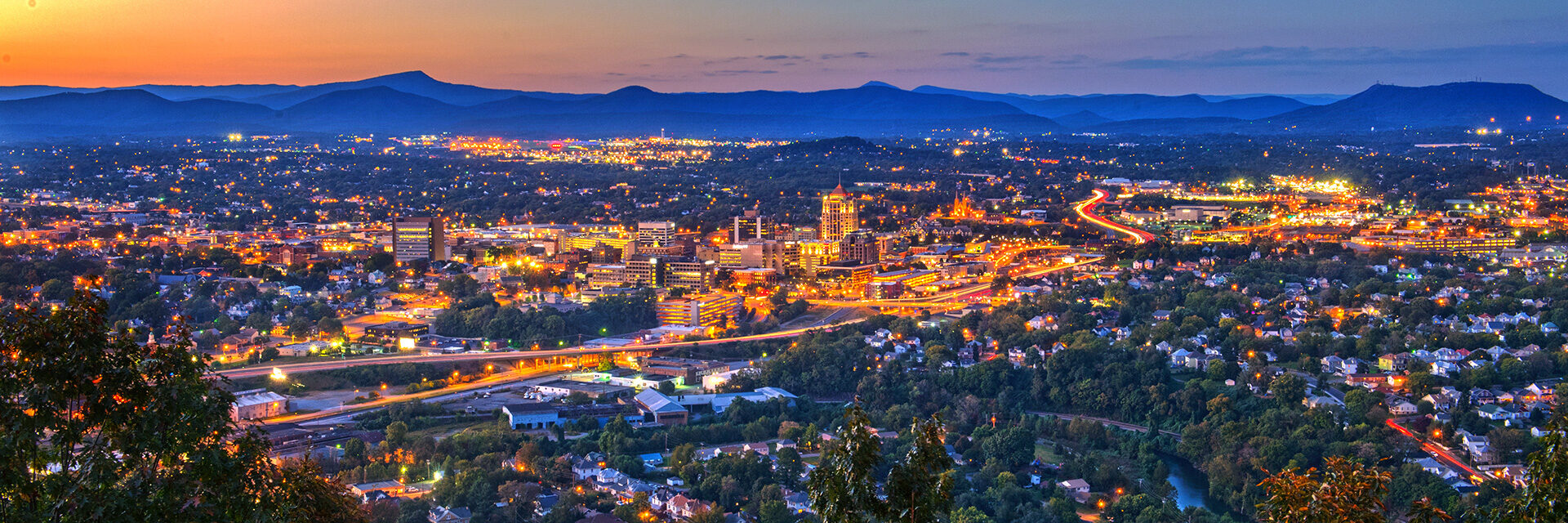
Thrive 2027: A Forward-Thinking, Five-Year Strategic Plan
Thrive 2027 five-year strategic plan will boost the region’s economic growth and enhance the competitiveness of the Roanoke Region to attract investment, jobs, and talent.
Emerging from 2020, economies around the world have refocused efforts toward stability in growth like never before. The Roanoke Region’s five-year vision is to realize our potential as a thriving, innovative economy that is inclusive of diverse businesses and talent, with a robust supply of sites, healthy infrastructure, and an array of lifestyle amenities and activities. We must leverage our regional assets, and build on past successes to ensure our region continues to thrive for years to come.
The plan below is the Partnership’s proposed course of action to achieve that end. To ask questions or contribute to the future of our region please contact our executive director, John Hull.
THRIVE 2027 INITIATIVES
The Roanoke Regional Partnership commissioned Ernst & Young Economic Development Advisory Services on a strategic planning process that will direct the organization’s body of work through 2027. The consultant team and Partnership staff conducted a public survey, engaged stakeholders in interviews and focus groups, and launched a detailed competitive assessment of the regional market and its opportunities. Key indicators were benchmarked and a SWOT analysis was completed to help shape the strategy. Four major priority areas have emerged during this process.
- Economic Growth and Innovations
- Talent Attraction and Workforce Development
- Commercial Real Estate and Infrastructure
- Place Making and Livability
Diversity, Equity, and Inclusion Statement:
The Roanoke Regional Partnership believes the area’s full potential is realized when diversity, equity, and inclusion are the standards upon which we strengthen and impact our businesses and communities. The organization is committed to cultivating inclusive economic opportunity for all who call our region home in performing its mission.
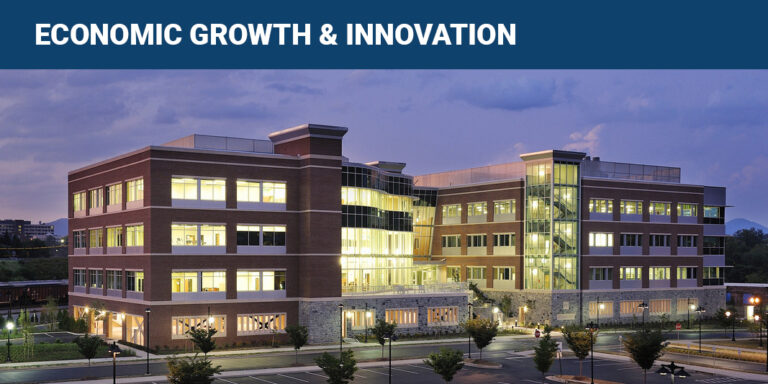
Economic Growth and Innovation
Goal: Grow the Roanoke regional economy by amplifying business recruitment and expansion (BRE) efforts, strengthening technology and innovation, and generating more high-paying jobs.
Objective 1.1 Elevate business recruitment, expansion, and retention activities.
Enhance business investment cultivation through strengthened partnerships, increased marketing, and media relations, and coordinated business retention and expansion initiatives.
Proposed Tactics:
- Build upon relationships with existing economic development partners (i.e. VEDP, Verge, chambers, SBDC, Advancement Foundation, Go Virginia, etc.) through consistent communications, touchpoints, and collaborations.
- Expand interactions with site selection consultants and business relocation and expansion decision-makers through in-person and virtual tours, outreach, and marketing trips to places with high concentrations of Roanoke’s target industry clusters.
- Engage in proactive, media relations to raise awareness of the region.
- Invest in technologies that will allow the Roanoke Regional Partnership to give virtual site tours to prospects.
Objective 1.2 Boost the region’s reputation as a technology and innovation hub.
Create a compelling narrative and communications strategy with input from education leaders and researchers, business executives and entrepreneurs, and public sector leaders.
Proposed Tactics:
- Engage experienced, professional, public relations assistance to earn international media attention.
- Gain commitment from key stakeholders to share information that will craft a strong technology and innovation story that can be used in the media strategy.
- use the RRP’s digital platforms (web, email newsletters, and social media) to amplify messaging.
- Feature businesses and individuals who are regional innovation leaders in stories on RRP digital platforms.
- Share content as appropriate with RoanokeInnovates.com, VEDP.org, and other platforms to amplify reach.
Objective 1.3 Contribute to the success and retention of entrepreneurial companies.
Support start-ups and high-growth firms with relevant market intelligence, business-to-business introductions, site availability insights, and more.
Proposed Tactics:
- Identify and include small, innovative, and growing companies in regional business response and efforts.
- Raise awareness that the Partnership’s market insights, other research, and knowledge of data sources are available to area entrepreneurs and business owners.
- Assist with search needs to connect entrepreneurial firms to available real estate or the brokerage community. Provide feedback that will inform new developments that meet the needs of emerging companies.
- Partner with the RAMP Regional Accelerator, SBDC, and Advancement Foundation to assist companies with insights, resources, and services.

Talent Attraction and Workforce Development
Goal: Expand efforts to attract and retain in-demand talent.
Objective 2.1 Lead talent attraction marketing efforts for a young, diverse and skilled workforce.
Leverage the Partnership’s marketing expertise and established image in outdoor recreation in a larger program promoting the region’s livability and career opportunities to out-of-market talent.
Proposed Tactics:
- Continue leading regional talent attraction efforts targeted to select geographies and occupations through a multi-platform digital campaign.
- Highlight in digital formats the stories of individuals who have built satisfying careers and lifestyles in the region, whether they stayed after graduation, returned after moving away, relocated with remote work, or relocated for a career opportunity.
- Explore opportunities with local college and university alumni associations to integrate talent attraction messaging into their web, email, and social media communications.
- Continue the Experience conference and the Get2KnowNoke summer internship program as ways to help retain local students and recruit those from other geographies.
- Continue Get2KnowNoke retention efforts through social programming that not only targets young professionals but mid-career and remote workers new to the region.
- Host organized receptions around events that attract a large number from outside the region (i.e., Blue Ridge Marathon and Ironman) to deliberately pitch the Roanoke Region as an ideal place to live and work.
Objective 2.2 Collaborate with education and workforce development partners to better align talent programs with employer needs.
Serve as a strategic partner and connector to help businesses engage more seamlessly with education and training initiatives.
Proposed Tactics:
- Create a business response team in collaboration with local governments, chambers, educators, and workforce agencies to build a forum to better identify, understand, and collaboratively address shared concerns and challenges (including talent) affecting business and economic growth and share information with agencies and policymakers that can address them.
- Develop a digital Roanoke Region employer guide that includes a listing and map of all of the talent and workforce resources in the region, with brief descriptions and web links that can be updated and refreshed as needed.
- Organize an annual retreat for talent and workforce partners to coordinate and set priorities and objectives for the year, along with mid-year check-in to update on progress. Local business and education leaders can share insights on issues such as skill supply, diversity and inclusion, and economic equity. The Partnership can compile and present data on talent and workforce issues.
Objective 2.3 Foster opportunities for greater diversity in the region’s workforce and leadership.
Ensure diversity is reflected in communications and all efforts of the Roanoke Regional Partnership. Identify ways to foster growth of diverse leadership.
Proposed Tactics:
- Identify subject matter experts and content that can be shared with employers through members of the business response team on matters of diversity, equity, and inclusion.
- Create partnerships with nonprofits to market volunteer opportunities to Get2KnowNoke participants with the aim of giving young professionals a sense of ownership over the community.
- Form a Get2KnowNoke advisory committee of diverse, young professionals to inform retention efforts and strategies.
- Launch a Get2KnowNoke talent ambassador program, consisting of diverse individuals who can collectively serve as “the face” of the region’s social media and other communications, as well as in-person recruiting events.

Commercial Real Estate and Infrastructure
Goal: Advocate for the acceleration of commercial and industrial real estate development and support advocacy for infrastructure improvement and funding.
Objective 3.1 Expand and strengthen the role of the Western Virginia Regional Industrial Facility Authority (WVRIFA) as the authoritative resource on real estate supply, trends, needs, and potential.
Be the voice in proactively identifying and addressing needs for business in commercial real estate and work to develop an inventory necessary for economic development.
Proposed Tactics:
- Utilize the WVRIFA, in consultation with its member governments and commercial real estate community to develop a real estate supply plan.
- Share findings with public and private sector partners to broker development.
- Determine the demand for spaces such as co-working centers, wet labs, spec buildings, and maker spaces targeted to startups.
Objective 3.2 Serve as a thought leader on issues and infrastructure affecting economic competitiveness.
Provide data and information to shed light on needs in areas such as transportation, broadband, workforce, and other infrastructure.
Proposed Tactics:
- Be an information resource to advocacy organizations such as chambers, local government, GO Virginia, and others.
- Serve as an information resource to the private sector by providing regular updates and special reports through chambers, The Business Council, Verge, and trade organizations.
- Continue to produce scheduled metrics reports on issues affecting economic competitiveness (workforce, livability, innovation, costs of living) and communicate to government, agency, and business audiences.
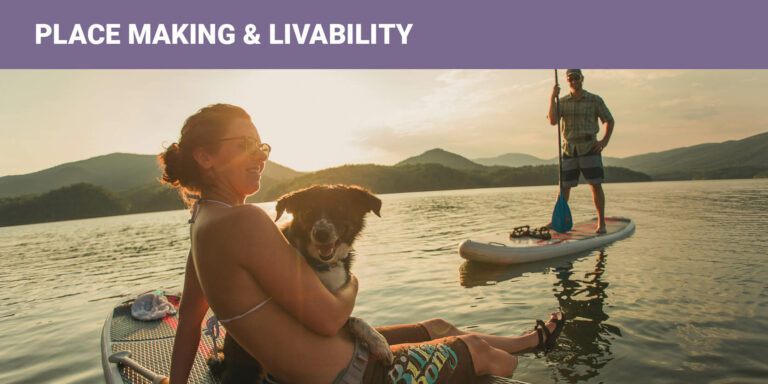
Place Making and Livability
Goal: Reinforce the region’s identity and competitive advantage as an outdoor destination, while highlighting other prominent lifestyle features and amenities, and supporting quality-of-life efforts.
Objective 4.1 Build on the success of Roanoke Outside with continued marketing and the development of sustainable funding for outdoors preservation and enhancement.
Sustain the region’s outdoors brand for business recruitment and talent attraction.
Proposed Tactics:
- Continue to incorporate the outdoor lifestyle message across business investment and talent attraction platforms.
- Convene business and government leaders to formulate and implement a sustainability model for outdoor assets and programs consisting of stable long-term funding sources.
- Be a thought leader on how the region can continue to build its outdoor brand through key public and private investment. Hold an annual conference on outdoor branding and assets to monitor progress in outdoor brand building.
- Grow the Blue Ridge Marathon and Go Outside Festival to continue to strengthen the outdoor brand.
Objective 4.2 Continue to build the Get2KnowNoke brand to promote the diverse character and amenities of the region to appeal to a wider audience.
Amp up the Partnership’s livability story to include a message that appeals to a wider audience while maintaining the central core of the outdoor lifestyle.
Proposed Tactics:
- Renovate Get2KNowNoke.com to better address a broad array of quality-of-life assets (such as live music, museums, collegiate sporting events, housing, K-12 schools, etc.) to appeal to a larger audience of recent graduates, remote workers, boomerangs, and relocating talent.
- Link all Partnership product lines across all websites.
- Add a more sophisticated job board on Get2KnowNoke.com.
- Integrate messaging and imagery across all Partnership brand lines.
Objective 4.3 Monitor emerging quality of life concerns and serve as a regional thought leader in regards to placemaking and quality of life.
Utilize the Partnership’s research and data analytics capability to track and report on issues that can have an adverse impact on economic competitiveness and livability. The research can help inform efforts to mitigate problems, such as housing availability and affordability, and access to quality childcare while expanding the Partnership’s reach in the broader community.
Proposed Tactics:
- Continue to produce scheduled metrics reports on issues affecting economic competitiveness with additional focus on placemaking and amenities and communicate to government, agency, and business audiences.
- Identify and support crowdfunding of additional placemaking amenities.
ABOUT THE ROANOKE REGIONAL PARTNERSHIP
The Roanoke Regional Partnership, established in 1983, is the regional economic development strategy and marketing organization for Alleghany, Botetourt, Franklin and Roanoke counties; the cities of Covington, Roanoke and Salem; and the Town of Vinton. The program of work includes business investment, outdoor asset development, talent attraction, market intelligence, and product development. The Partnership has worked with its partners to create more than 20,000 primary jobs and nearly $2.4 billion in investment by attracting companies such as Orvis, Altec, McAirlaids, Bimbo Bakeries, Cardinal Glass, Dynax, Balchem, Eldor, Mack Trucks, and others to the region.
Thrive 2027 is part of an every-five-year process that the Roanoke Regional Partnership undertakes to refine and expand its program of work to address current challenges and opportunities that will influence job growth, investment, population growth, and outdoor asset development. In 2017, this process led to the creation of the Get2KnowNoke talent attraction program and in 2007 sparked the creation of Roanoke Outside which created an economic sector in outdoor recreation, outdoor business and adventure tourism.
Strategic Plan Advisory Council
- Pete Huber, Alleghany County
- Tom Alcoke, Anthem Blue Cross Blue Shield
- Brad Hall, Appalachian Power
- Gary Larrowe, Botetourt County
- Donald Halliwill, Carilion Clinic
- Krystal Onaitis, City of Covington
- Bob Cowell, City of Roanoke
- James Taliaferro, City of Salem
- Jeff Merritt, Cox Communications
- John Rainone, Mountain Gateway Community College
- Deborah Flippo, Draper Aden
- Matt Fink, Fink’s Jewelers
- Christopher Whitlow, Franklin County
- Brett Marston, Gentry Locke
- Maryellen Goodlatte, Glenn, Feldman, Darby & Goodlatte
- Edward Smith, Marsh and McLennan Agency
- David Allen, Pinnacle Bank
- Victor Iannello, Radiant Physics
- Paul Nester, RGC Resources, Inc.
- Dan O’Donnell, Roanoke County
- Ken Randolph, Rockydale Quarries Corp.
- David Camden, Truist Bank
- Pete Peters, Town of Vinton
- Michael Friedlander, Ph.D., Fralin Biomedical Research Institute
- Arnie Adkins, Wells Fargo
- Abby Hamilton, United Way of the Roanoke Valley
- N.L. Bishop, Carilion Clinic
